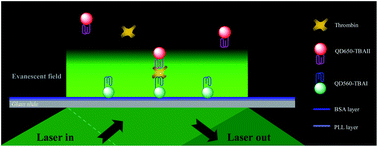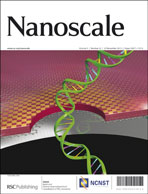Solid-phase single molecule biosensing using dual-color colocalization of fluorescent quantum dot nanoprobes†
Abstract
The development of solid-phase surface-based single molecule imaging technology has attracted significant interest during the past decades. Here we demonstrate a sandwich hybridization method for highly sensitive detection of a single thrombin protein at a solid-phase surface based on the use of dual-color colocalization of fluorescent quantum dot (QD) nanoprobes. Green QD560-modified thrombin binding aptamer I (QD560-TBA I) were deposited on a positive poly(L-lysine) assembled layer, followed by bovine serum albumin blocking. It allowed the thrombin protein to mediate the binding of the easily detectable red QD650-modified thrombin binding aptamer II (QD650-TBA II) to the QD560-TBA I substrate. Thus, the presence of the target thrombin can be determined based on fluorescent colocalization measurements of the nanoassemblies, without target amplification or probe separation. The detection limit of this assay reached 0.8 pM. This fluorescent colocalization assay has enabled single molecule recognition in a separation-free detection format, and can serve as a sensitive biosensing platform that greatly suppresses the nonspecific adsorption false-positive signal. This method can be extended to other areas such as multiplexed immunoassay, single cell analysis, and real time biomolecule interaction studies.


 Please wait while we load your content...
Please wait while we load your content...